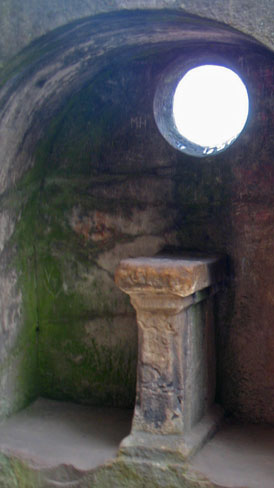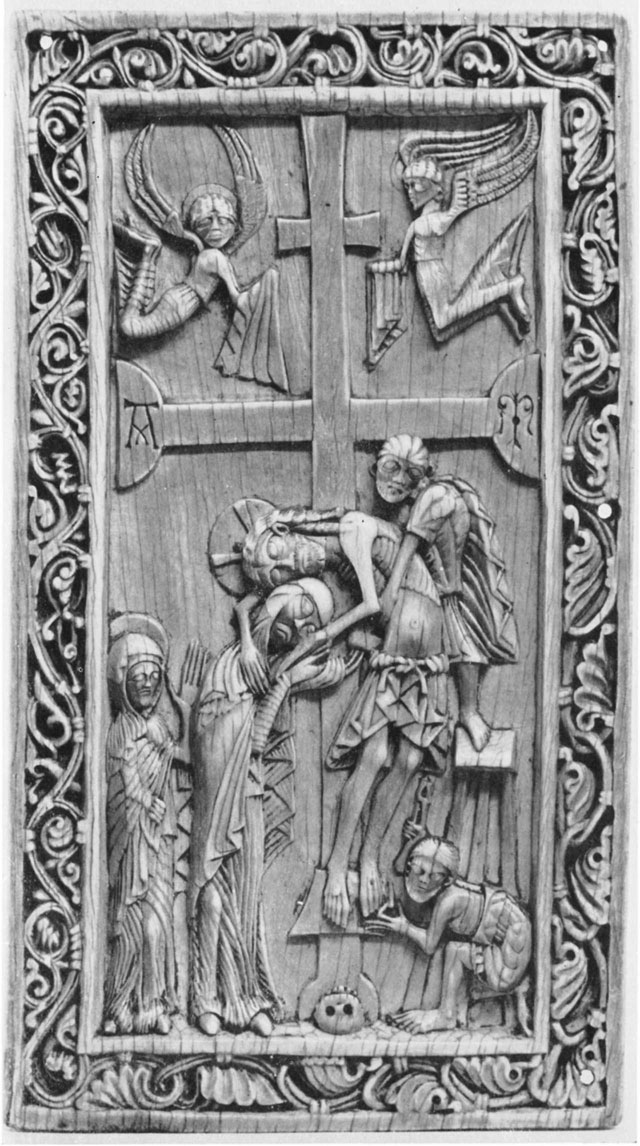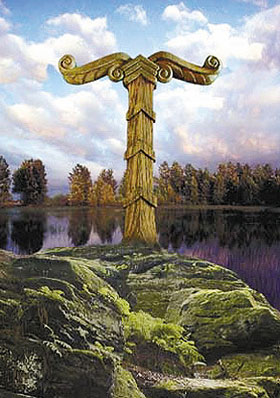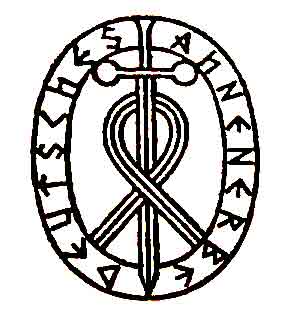We recently had the pleasure of visiting one of the most significant neo-pagan sanctuaries in Germany. Situated in the Teutoburg Forest, not far from the purported site of Arminius’ famed victory over the Romans, the Externsteine (‘Magpie Rocks’) are a magnificent row of towering rocky columns proceeding some 500 metres across a low wooded ridge to a small lake. In the cool of late autumn there weren’t many visitors, but there lingered a few folk for whom the rocks were evidently a deeply sacred site: a long-haired flautist playing an eerie psychedelic tune whilst seated upon a wooden hippo; a mad bagpiper clad in black, blasting out an apocalyptic dirge as he strutted frenetically to and fro; and a friendly, dreadlocked Aryan couple wandering amidst the rocks with a didgeridoo and a dog.
At the solstices and Walpurgisnacht the Magpie Rocks are not so quiet. During the last twenty years a steadily increasing number of neo-pagans have been gathering to celebrate at what they believe is an ancient Saxon shrine. According to the local forestry warden, it began with ‘a few dozen witches’ dancing under a chestnut tree in the 1980’s, then came ‘the bearskin people’ – followers of the ancient Germanic ways. And suddenly, inexplicably, the numbers attending swelled to around 800 in the midst of the 90’s, with New Agers, hippies, punks, Goths and the local youth joining Wiccans, Odinists and other neo-pagans to celebrate the festivities.
These have passed off in relative peace, although last year a dead chicken was found in the aftermath of the revelry, and it is said police once had to confiscate a goat bound for the same fate. More disturbingly, the presence of a handful of right-wing extremists has caused friction and provoked a call-to-arms by Antifa, a loosely-knit anti-fascist alliance of socialists, anarchists and autonomes. Indeed, while we were walking through the woods we saw a young man with closely-cropped hair and heavy boots atop one of the smaller pinnacles, which stretch along the forested ridge like the half-exposed vertebrae of some ancient beast. It’s easy to imagine we know something about people when in fact we are only acquainted with superficialities – not every long-haired neo-pagan is tolerant and peaceful, nor is every skinhead a fascist. Besides, he was chugging down a carton of milk – not very manly for a beer-swilling neo-Nazi, surely? But there was something oddly humourless in his grin…
The lake by the Magpie Rocks was created in the nineteenth century to please Romantic aesthetic sensibilities.
Whatever his sympathies might have been, the attraction of the Magpie Rocks for German nationalists has a long history. The notion that the rocks were ever a Saxon shrine stems from a sixteenth century Lutheran theologian, Hermann Hamelmann, who wrote that Charlemagne had destroyed a heathen sanctuary there. By the eighteenth century that sanctuary had become identified with the Saxon world tree, the Irminsul, torn down by Charlemagne in 772. The only detailed description of this object comes from the ninth century monk Rudolf of Fulda, who writes that the Saxons “worshipped in the open air a vertically-erected tree trunk of no mean size that they named in their mother tongue ‘Irminsul’, which in Latin means ‘columna universalis’, and which bore the universe in some fashion.”

A nineteenth century depiction of Charlemagne’s destruction of the Irminsul.
In 1926 an amateur archaeologist and anti-Semitic paramilitary member by the name of Wilhelm Teudt decided to find irrevocable proof that Externsteine had been the site of the Irminsul. Teudt had developed a knack for discovering the traces of bygone pagan institutions amidst the landscape – academies, astronomical observatories, stadiums for combat sports and the like – in his quest to prove the pagan Germans were possessors of a ‘high culture’. The Magpie Rocks are riddled with grottos and hewn passageways; near the summit of the so-called Turmfels or Tower Crag, the tallest of the pinnacles, a rectangular room known as the High Chamber has been chiselled out of the hard sandstone. To an untrained eye such as my own this chamber appears to be a small medieval chapel, complete with a circular window above a stone altar; but to Teudt this was a pagan ‘solar observatory’, the altar being a well-worn seat where the Saxon high priest would peer through the ‘sun window’ to await the rising of the sun at the summer solstice. What is more, a large and very fine relief of the deposition of Christ from the cross is carved at the base of the neighbouring crag. Whilst it would be hard to interpret this as a pagan work, Teudt saw a representation of the Irminsul in the ‘stool’ upon which Nicodemus stands to reach the body of Jesus.

In 1933 Teudt joined the Nazi party and suggested that the Externsteine be transformed into a ‘sacred grove’ to commemorate the pagan ancestors. His call was heeded by no less a crackpot and criminal than Heinrich Himmler, who appointed himself chairman of the ‘Externsteine Foundation’ and initiated an archaeological dig by the German Ancestral Heritage Research Association (that’s right, the guys from ‘Raiders of the Lost Ark’). Himmler issued a decree that both Jews and their German friends were banned from the site, since they “cannot have and do not wish to have the necessary understanding of this ancient Germanic shrine”. Soon the regional newspaper carried the headline “Externsteine forbidden for Jews – Germanic holy shrines only for Germanic people”. In the course of the excavations Teudt and his partners in archaeological crime managed to unearth a ‘stone table’ (i.e. slab rubble from the crag above) which they ‘reconstructed’ with the help of a little concrete and presented as “the sacred remains of quintessential folk tradition”, while the traces of a seventeenth century fortification were interpreted as the vestiges of a pagan ‘cult of the dead’ remarkably similar to the Nazi party’s own Remembrance Day ceremonies.
Symbol of the German Ancestral Heritage Research Association (Forschungsgemeinschaft Deutsches Ahnenerbe e. V.)
Although Adolf Hitler aimed to “wash off the Christian veneer and bring out a religion peculiar to our race”, the activities at the Externsteine evidently left him unimpressed. Speaking in 1942, der Führer added yet another half-baked theory to the record when he declared that the outcrop “certainly was not a cultic sanctuary, but rather a place of refuge to which the people retreated to escape the rising mire.”
Since the war, research on the Magpie Rocks has relied less on vague intuitions or the channelling of ancestral spirits. Excavations have revealed no finds whatsoever from the pagan Saxon period, while ceramic and metal objects unearthed by the Nazis have been dated to the eleventh and twelfth centuries at the earliest, i.e. well after Charlemagne’s Christianization of the Saxons. Three traces of fire in the main grotto which may or may not stem from its creation have recently been subjected to optically stimulated luminescence (OSL) dating; the earliest of them was produced in 1030 AD (+/- 100 years). This does not contradict an inscription in the main grotto stating it was consecrated by the bishop of Paderborn in 1115, and later medieval records document the site’s use by anchorites. An adjacent smaller grotto has fire traces dating at the earliest to the middle of the ninth century, i.e. the time of the revolt of the pagan Stellinga. As the weathered figure of St. Peter and his key carved at the grotto’s entrance suggests, its original purpose was probably Christian.

The 'sun window' in the High Chamber.
And what of the ‘solar observatory’ atop Tower Crag? An astronomer from the Ruhr University at Bochum recently threw his weight behind Teudt’s theory when he discovered marks around the rim of the ‘sun window’ which ‘might’ have been made by prehistoric stone implements; furthermore, around the year 0 the rising sun at the solstice would have cast its light directly into the High Chamber. To my mind, however, these ‘facts’ are evidence of nothing more than a strong desire to believe the improbable, as the design of the ‘sun window’ merely recalls the circular windows to be found in many Romanesque German churches and chapels. What is more, given the rectangular dimensions of Tower Crag, it would have been hard to orientate the chamber, its altar and its window in any other direction.

The Magpie Rocks with Tower Crag at the left.
While Teudt and his theories are an easy target for ridicule, even a broken clock is right twice a day. However flawed his methods and however distasteful his viewpoints were, Teudt’s identification of an Irminsul in the relief carving of the Deposition of Christ deserves greater attention than it has received. Goethe dated this relief to the Carolingian period and pointed to Byzantine influences, while modern scholarship has tended to view the work as roughly contemporaneous with the aforementioned inscription of consecration from 1115. In either case, the ‘stool’ upon which Nicodemus stands to reach the body of Christ is a very curious object:

Firstly, it should be remarked that the Deposition is not a common artistic subject in the period concerned, and when it is depicted Christ is either low enough to make a stool unnecessary or a ladder is shown placed up against the cross. Occasionally, however, the scene is represented with a stool, as in this English ivory panel from c. 1150:

Evidently the object on the Externsteine relief is altogether dissimilar to a stool; and in case you’re imagining Nicodemus just happened to find a fancy chair at an execution ground, look at these two examples of twelfth century Romanesque chairs. On the other hand, there is a Carolingian tradition of representing the Christian conquest of paganism with the symbol of a bent tree - consider these words of a poem from 814 in praise of the holy cross by Rabanus Maurus, teacher of Rudolf of Fulda and confidante of the Carolingian rulers: "The yew of ill omen retreats, while the rush and the pine humbly bow before the cross." Hence there is every possibility that we are dealing with the portrayal of a bent tree at Externsteine, and as such the relief there is – to the best of my limited knowledge – unique. Furthermore, if a tradition existed into the sixteenth century concerning the presence at the Externsteine of a heathen sanctuary destroyed by Charlemagne, then the relief may well incorporate a piece of local folklore, if not local history. If this is the case then the symbolic import of a bent tree next to the Cross could not be clearer – the Irminsul has fallen, Christ is triumphant. What is more, the depiction of Adam, Eve and the Serpent by the Tree of Life at the base of the relief would reflect the custom of amalgamating pagan motifs with Christian mythology: heathen sin is surmounted by redemption through Christ’s sacrifice. Even if the relief dates to the twelfth rather than the ninth century, Christianity’s defeat of Saxon paganism was momentous enough to occasion a yearly celebration of the Irminsul’s downfall in nearby Hildesheim well into the thirteenth century. After all, this was a time when paganism not only lingered in local folk belief but remained unsubdued in the Baltic states.

The Irminsul of the Germanic neo-pagan grouping Ásatrú is derived from the Externsteine relief.
Be this as it may, the Magpie Rocks are without question a magnificent natural and cultural landmark with universal appeal, and I would thoroughly recommend you visit, whatever your race might be. On our last morning there, as we stood by the rocks and the sun finally emerged from a blanket of clouds, there was a moment which seemed to confirm the remarkable power of that place in the face of any scholarly discussion or ideologically-driven debate. Every few minutes a gust of wind would roll like a slow wave through the trees around the crags, the breath of some lost god sending a shower of golden leaves glittering down through the sunlight. I stood there for ages with my camera, trying in vain to capture the beauty of that fleeting moment, but it was irreducible, ineffable – the heritage of all humankind and the living heart of art and religion, of which our science is but a faint reflection.





